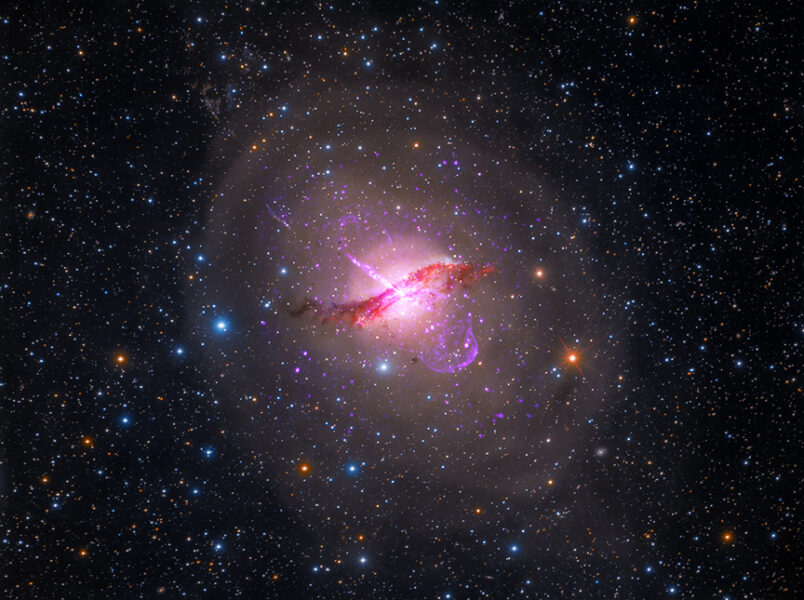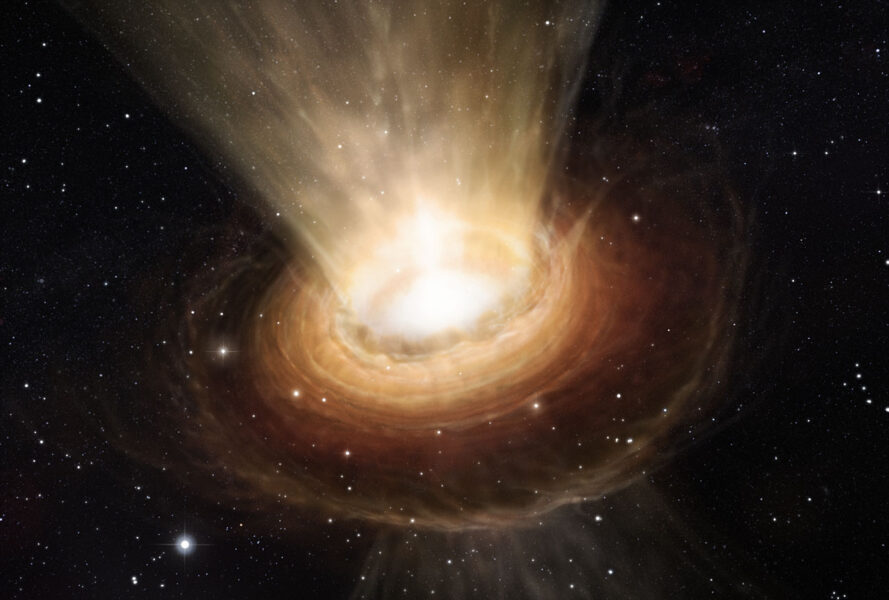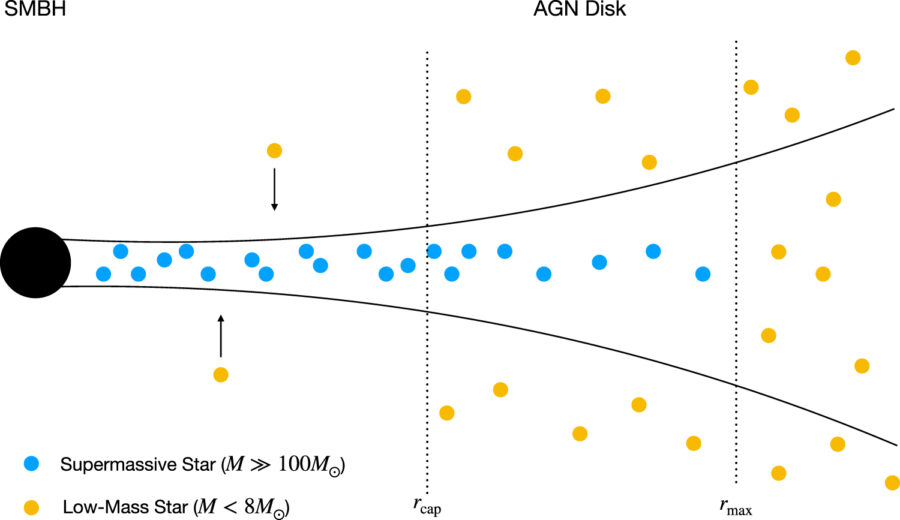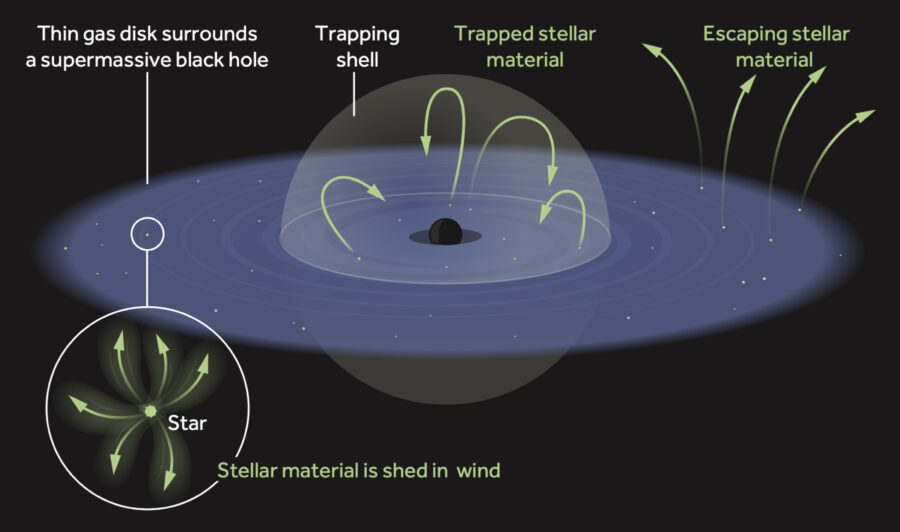Under the right conditions, stars could become immortal. How is this possible, and what does it mean for these stars’ surroundings?

X-ray: NASA / CXC / SAO; Optical: Rolf Olsen; Infrared: NASA / JPL-Caltech
Stars have been singing the same song since the beginning of the universe: you’re born, you fuse hydrogen into helium, you drift off the main sequence, and finally, you’re recycled into the cosmos. Under the right conditions, though, stars could become immortal. How is this possible, and what does it mean for these stars’ surroundings?
Live Fast, Die Never

ESO / M. Kornmesser
Many galaxies host an active galactic nucleus — a luminous disk of gas and dust circling a central supermassive black hole. Extreme though this environment may be, stars can live within these disks, and astronomers suggest that some of these stars might be immortal.
As these stars churn hydrogen into helium in their cores, they constantly replenish their hydrogen stores from the surrounding disk. As a result, they never run out of fuel, never leave the main sequence, and never die. Now, a team led by Adam Jermyn (Flatiron Institute) has explored how these extreme stars might affect the evolution of the disk that surrounds them.
Drinking from the Stellar Fountain of Youth

Jermyn et al. / Astrophysical Journal 2022
Jermyn and collaborators considered disks with short (0.1 million years) and long (10 million year) lifetimes, estimating that these disks would capture 1,000 and 20,000 stars, respectively, from the inner regions of their galaxies. The short-lived disk only contains enough mass to raise 300 of these stars to immortality, while the long-lived disk can support all 20,000 stars.
In both disks, the immortal stars grow to 300 solar masses and have massive convective cores. The constant churning brings fresh hydrogen to their cores and transports helium outward to their surfaces. From there, fierce stellar winds carry the helium-rich gas out into the disk, boosting the abundance of helium near the black hole. The consequences of this chemical enhancement aren’t yet clear — it might rob immortal stars of their superpowers, since sucking up helium-rich material will make them burn through their hydrogen faster than it can be replenished — but measuring helium abundances in active galactic nuclei may provide a way to test the degree of chemical enrichment.
Immortal No More

Jermyn et al. / Astrophysical Journal 2022
Do immortal stars help or hinder the disk’s survival? Both outcomes are possible. These stars’ winds likely replenish the inner regions of the disk, but they may also drive material to escape the outer regions of the disk. In addition, active galactic nuclei don’t remain active forever — as the disk begins to dissipate, the stars shed much of their mass, giving the disk a last boost before the stars cross back to the mortal realm and evolve into black holes.
The authors note that their estimates are still uncertain, but it’s clear that immortal stars can play an important role in the evolution of the innermost regions of a galaxy. Future work might explore the consequences of helium-enriched gas spiraling around a supermassive black hole or assess the impacts of stars that form within the disk itself. Clearly, immortal stars provide plenty of work for modelers and observers alike — immortality might be beyond our reach, but at least we can live vicariously through these stars!
Citation
“Effects of an Immortal Stellar Population in AGN Disks,” Adam S. Jermyn et al 2022 ApJ 929 133. doi:10.3847/1538-4357/ac5d40
This post originally appeared on AAS Nova, which features research highlights from the journals of the American Astronomical Society.
 5
5









Comments
Anthony Barreiro
June 2, 2022 at 5:46 pm
"Jermyn and collaborators considered disks with short (0.1 million years) and long (10 million year) lifetimes ... . ... [A]ctive galactic nuclei don’t remain active forever — as the disk begins to dissipate, the stars shed much of their mass, giving the disk a last boost before the stars cross back to the mortal realm and evolve into black holes."
Considering that low mass stars persist for billions to trillions of years, it seems a bit of a stretch to call a star that lasts for 10 million years "immortal." But I guess "Effects of a Hypothesized Unusually Long-Lived High-Mass Stellar Population in AGN Disks" would make a less compelling title and get fewer clicks.
You must be logged in to post a comment.
Thomas Haas
June 4, 2022 at 12:25 pm
Exactly my thinking. A bit more precision would do no harm at all !!!
Somewhere here I saw a reference to the "diameter of a hydrogen atom" - what the heck is that supposed to mean ? Just the proton ? Then that's what it should be called. But that is not a hydrogen atom .... And the diameter of a hydrogen atom including the electron (not the Van der Waals, ionic, metallic or covalent diameter) cannot even be clearly defined as the orbital or electron cloud is just a probability distribution ....
You must be logged in to post a comment.
Howard Ritter
June 5, 2022 at 9:02 am
It looks to me like the authors use the term "immortal" to mean "temporarily non-aging" or "non-evolving". The constant replenishment of H and disposal of He cause the usual main-sequence process of chemical evolution to be put on hold for as long as conditions in the disk allow this equilibrium to be maintained.
If the usual 10^-2 scaling of stellar lifetime as a function of mass held for the hypothesized 300-M(Sun) giants, their expected lifetime would be something like 100,000y. That's 1% of the life span of a long-lived disk. So while it ain't immortality, it's a hundred times the norm. (In reality, these stars are so far out of the ordinary that the usual dependency of luminosity, and therefore life span, on mass likely doesn't hold, and the life span of such stars away from the big city is more like 1My. So in a 10My disk, extremely high-mass stars may live "only" 10 times as long as their country cousins.)
“Effects of a Hypothesized Population of Non-Aging Ultrahigh-Mass Stars in AGN Disks” still doesn't have that zing.
You must be logged in to post a comment.
Anthony Barreiro
June 5, 2022 at 5:19 pm
Upon further reflection, the title should be "Hypothesized Effects of an Imagined Population of Unusually Long-Lived High-Mass Stars in AGN Disks."
You must be logged in to post a comment.
Mountainfisher
June 3, 2022 at 9:28 pm
My understanding is that there isn't any power system in this Universe that will truly be immortal. The fusionable material will eventually run out and the Universe will die in a slow heat death. As it appears the Universe is accelerating its expansion there will eventually be sub-atomic particles with light years of space between each one.
These "immortal" stars will run out of their energy source. Immortal is forever, not a really really long time. Just like nothing is not a little something. How can physicists and astronomers acquire advanced degrees and even fame in their fields and not understand basic logic makes me wonder how they got so far. Worse yet is, how did the bar get so low?
I am in my final years and the rank speculation that sometimes passes for science is perhaps driven by metaphysics? Materialism is not science, it is a methodology for looking at nature, but in itself it is a metaphysical position that cannot be proven.
Science is the study of nature in a materialist framework, stay in the material world, but that doesn't prove this material world does not have something outside it. Science stops there and should.
You must be logged in to post a comment.
You must be logged in to post a comment.